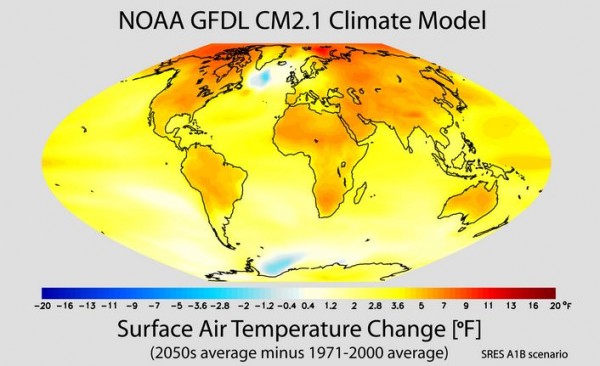The Earth is "Sick" and Getting "Sicker"
| Arthur Dominic Villasanta | | Jul 20, 2014 11:22 PM EDT |
Planet Earth's annual health check-up shows the Old Lady to be "sick" and somewhat too hot.
The "State of the Climate Report 2013" just released by the U.S National Oceanic and Atmospheric Administration (NOAA) reported the Earth has set new records for greenhouse gases, rising sea levels, Arctic heat and warm ocean temperatures.
Like Us on Facebook
The Earth's climate records in 2013 continued a long-term rising trend in global temperatures
NOAA said 2013 was between the second- and sixth-hottest year on record for the Earth since records began being kept starting 1880. NOAA administrator Kathryn Sullivan Ph.D. likened NOAA'S climate report to "an annual checkup on the planet."
The report shows that climate data from air, land, sea and ice confirm trends of a warming Earth. In 2013, the vast majority of worldwide climate indicators such as greenhouse gases, sea levels and global temperatures continued to reflect trends of a warmer planet.
The report was compiled by 425 scientists from 57 countries around the world and provides a detailed update on global climate indicators, notable weather events, and other data collected by environmental monitoring stations and instruments on air, land, sea and ice.
"These findings reinforce what scientists for decades have observed: that our planet is becoming a warmer place," said Sullivan.
"This report provides the foundational information we need to develop tools and services for communities, business, and nations to prepare for, and build resilience to, the impacts of climate change."
Highlights of the report:
Greenhouse gases continued to increase in 2013. Major greenhouse gas concentrations including carbon dioxide (CO2), methane and nitrous oxide rose once again and hit historic high values in 2013.
Atmospheric CO2 concentrations rose by 2.8 ppm in 2013, pushing the global average to 395.3 ppm for the year. The daily concentration of CO2 exceeded 400 ppm on May 9 at the Mauna Loa Observatory in Hawaii for the first time since measurements began here in 1958.
This somber milestone follows observational sites in the Arctic that observed this CO2 threshold of 400 ppm in the spring of 2012.
Warm temperature trends continued near the Earth's surface with four major independent datasets showing that 2013 was among the warmest years on record, ranking between second and sixth.
In the Southern Hemisphere, Australia observed its warmest year on record. Argentina had its second warmest and New Zealand its third warmest.
Sea surface temperatures increased. Four independent datasets indicate the globally averaged sea surface temperature for 2013 was among the 10 warmest on record. The North Pacific was record warm for 2013.
Sea level continued to rise. The global mean sea level continued to rise during 2013, on pace with a trend of 3.2 ± 0.4 mm per year over the past two decades.
The Arctic continued to warm and sea ice extent remained low. The Arctic observed its seventh warmest year since records began in the early 20th century.
Record high temperatures were measured at 20-meter depth at permafrost stations in Alaska. Arctic sea ice extent was the sixth lowest since satellite observations began in 1979. All seven lowest sea ice extents on record have occurred in the past seven years.
Tropical cyclones reached their near average overall. There were a total of 94 storms, slightly above average in comparison to the 1981-2010 average of 89.
In the Western North Pacific Basin, Super Typhoon Haiyan was the deadliest cyclone of 2013. Haiyan had the highest wind speed ever assigned to a tropical cyclone with one-minute sustained winds of 196 miles per hour.
TagsEarth, Getting, Sicker, temperatures
©2015 Chinatopix All rights reserved. Do not reproduce without permission
EDITOR'S PICKS
-

Did the Trump administration just announce plans for a trade war with ‘hostile’ China and Russia?
-

US Senate passes Taiwan travel bill slammed by China
-

As Yan Sihong’s family grieves, here are other Chinese students who went missing abroad. Some have never been found
-

Beijing blasts Western critics who ‘smear China’ with the term sharp power
-

China Envoy Seeks to Defuse Tensions With U.S. as a Trade War Brews
-

Singapore's Deputy PM Provides Bitcoin Vote of Confidence Amid China's Blanket Bans
-

China warns investors over risks in overseas virtual currency trading
-

Chinese government most trustworthy: survey
-

Kashima Antlers On Course For Back-To-Back Titles
MOST POPULAR
LATEST NEWS
Zhou Yongkang: China's Former Security Chief Sentenced to Life in Prison

China's former Chief of the Ministry of Public Security, Zhou Yongkang, has been given a life sentence after he was found guilty of abusing his office, bribery and deliberately ... Full Article
TRENDING STORY

China Pork Prices Expected to Stabilize As The Supplies Recover

Elephone P9000 Smartphone is now on Sale on Amazon India

There's a Big Chance Cliffhangers Won't Still Be Resolved When Grey's Anatomy Season 13 Returns

Supreme Court Ruled on Samsung vs Apple Dispute for Patent Infringement

Microsoft Surface Pro 5 Rumors and Release Date: What is the Latest?










